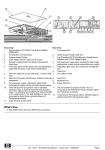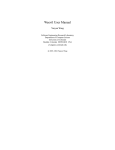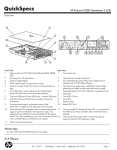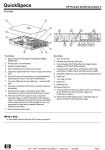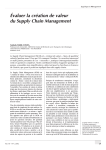Download User Guide for Heterogeneous Subset Sampling Library
Transcript
User Guide for Heterogeneous Subset Sampling
Library
October 9, 2011
Contents
1 Outline
2
2 Subset Drawing Algorithms
2.1 constructor . . . . . . . . . . . . . . . . . . . . . . . . . . . . .
2.2 drawing member function . . . . . . . . . . . . . . . . . . . . . .
2
2
3
3 Building Blocks
3.1 The cuckoo hashing . . . . . . . . . . . . . . . . . . . . . . . . .
3.2 The radix sorting . . . . . . . . . . . . . . . . . . . . . . . . . .
3.3 The fittest covering . . . . . . . . . . . . . . . . . . . . . . . . .
4
4
6
7
4 Testing Platforms and Programs
8
A GSL Installation Guide
9
1
1 Outline
Given a domain set S = {0, 1, . . . , n − 1} and an associated inclusion probability
function I : S → [0, 1], a subset drawing algorithm is used to draw a subset R, possibly many subsets, of S where Pr[e ∈ R] = I(e). We use C++ to implement the algorithms in the form of class. There are two main member functions in the classes,
which are the constructor and drawing function. The algorithms are preprocessed
in the constructor and a drawn subset can be obtained by invoking their drawing
function. Note that the HSS library requires a open third-party library GSL and we
show how to install it in the appendix.
In this article, bold text is used for explaining the terms in the programs and
code segments are written in typewriter text. The remaining is organized as
follows. In Section 2, we details the steps how the algorithms are used. For inspecting the internal codes, we state the module purpose and the parameters’ description of the building blocks in Section 3. Then, in Section 4, a list of testing
platforms is shown and the testing programs are briefly explained.
2 Subset Drawing Algorithms
The subset drawing algorithms introduced in this section are
• naive<size>,
• sieve<size>,
• partition<size>,
where size is an integral type to denote n = |S|. There are two main member functions in each subset drawing algorithm, which are the constructor and drawing
function.
2.1
constructor
naive
sieve
partition
partition
naive(size n)
sieve(double const *prob, size n)
partition(double const *prob, size n, size const *cut_points, size k)
partition(double *prob, size n, int algorithm_type)
Table 1: Class constructors of subset drawing algorithms.
prob[0 .. n-1] refers to n inclusion probabilities and cut_points[0 .. k] denote
how to partition the original single prob[0 .. n-1] into k ones. For example,
partition(prob, 5, cut_points={0, 2, 5}, 2)
2
divides {prob[0 .. 4]} into {prob[0 .. 1]} and {prob[2 .. 4]}. In the partition algorithm, an user can give cut_points to divide prob as shown above or merely specifies the preferred dividing algorithm among HSS_OPTIMUM, HSS_FIX_APPROX,
and HSS_DYN_APPROX (Table 2).
HSS_FIX_APPROX
HSS_OPTIMUM
HSS_DYN_APPROX
A fixed partition method of approximation factor 2.
The optimum algorithm of the fittest cover problem.
The approximation algorithm of the fittest cover problem.
Table 2: Preprocessing algorithms for the partition algorithm.
Note
The 4-th constructor in Table 1 modifies the content in prob.
Example
#include <hss.h>
int main(){
double prob[5] = {0.1, 0.2, 0.3, 0.7, 0.9};
int cut_points[3] = {0, 3, 5};
naive<int> drawer1(5);
sieve<int> drawer2(prob, 5);
partition<int> drawer3(prob, 5, cut_points, 2);
partition<int> drawer4(prob, 5, HSS_DYN_APPROX);
return 0;
}
See Also
include/naive.h, include/sieve.h, include/partition.h, test/test[5-8].cpp
2.2
drawing member function
Three classes have the same member function used to draw a subset, which is
size drawing(double *prob, size *subset).
To reduce the amount of used space, the class objects do not have a duplicate of
prob. Hence, prob should be given for each drawing. During execution, the value
of elements in prob can only be decreased down, otherwise the drawn sample
3
R does not satisfies the condition that Pr[e ∈ R] = I(e). The return value ret of
drawing(prob, subset) is the size of drawn sample placed in subset[0 .. ret-1].
Example
#include <cstdio>
#include <hss.h>
int main(){
double prob[5] = {0.1, 0.2, 0.3, 0.7, 0.9};
int subset[5];
partition<int> drawer(prob, 5, HSS_DYN_APPROX);
for(int i=0; i<10; ++i){
int ret = drawer.drawing(prob, subset);
for(int j=0; j<ret; ++j){
printf("%lf ", prob[subset[j]]);
}
printf("\n");
}
return 0;
}
See Also
include/naive.h, include/sieve.h, include/partition.h, test/test[5-8].cpp
3 Building Blocks
In this section, the building blocks used in the constructors of the partition algorithm are introduced.
3.1
The cuckoo hashing
The cuckoo hashing is a hash table used to store a series of keys and their associated data, which supports amortized O(1) time insertion, O(1) time lookup, and
O(1) time deletion [1]. We follow the convention of the well known STL map1 to
implement
cuckoo_hash<key, data, size>
1 http://www.sgi.com/tech/stl/Map.html
4
and its the member functions, including
• cuckoo_hash(size), ∼cuckoo_hash()
• iterator begin(), iterator end(), size size()
• iterator find(key), data &operator[ ](key)
• iterator, const_iterator
Note
1. key is a native C++ data type of size no more than 8 bytes.
2. data is the type of associated data.
3. size is a signed integral data type, which counts the number of keys in a hash
table. The maximum number of stored keys should not exceed the maximum
of size minus 1.
4. Users can define the initial table size by assigning the parameter ptabsize
in the constructor cuckoo_hash(ptabsize). Once the space run out, the
cuckoo_hash automatically double the table size.
Example
#include <iostream>
#include <hss.h>
int main(){
double input[5] = {0.1, 0.1, 0.2, 0.2, 0.2};
cuckoo_hash<double, int, int> s(100);
cuckoo_hash<double, int, int>::const_iterator ite;
for(int i=0; i<5; ++i){
double key = input[i];
if(s.find(key) == s.end()){ // if key is not found
s[key] = 1;
}else{
++ s[key];
}
}
for(ite=s.begin(); ite!=s.end(); ++ite){
std::cout << ite->first << " " << ite->second << std::endl;
5
}
}
See Also
include/cuckoo.h, test/test1.cpp
3.2
The radix sorting
radixsort(data * f irst, data *last, std::vector<int> lsb) is a sorting procedure
used to sort the elements of fixed precision between first and last by the least significant bits, the second least significant bits, . . . , the most significant bits defined
in lsb. The required computation time is O(nb) = O(n) [2] where n is the number
of elements and b is a constant, due to fixed precision, denoting the number of bits
in an element.
data
int
double
long long
feasible lsb
{8, 8, 8, 8} or {16, 8, 4, 4}
{13, 13, 13, 13, 12} or {26, 26, 12}
{16, 16, 16, 16} or {15, 15, 15, 15, 4}
Table 3: data and the corresponding lsb.
Note
1. data a data type that support right-shiftment » and bitwise-and &.
2. The elements between first and last should be non-negative.
3. In the case of double, use long long as an adapter and invoke radixsort(first,
last, lsb, adapter).
Example
#include <iostream>
#include <vector>
#include <hss.h>
int main(){
long long s[3] = {3, 1, 2};
int lsb1[4] = {16, 16, 16, 16};
radixsort(s, s+3, *new std::vector<int>(lsb1, lsb1+4));
6
double r[4] = {5.0, 1.0, 3.0, 2.0};
int lsb2[5] = {13, 13, 13, 13, 12};
radixsort(r, r+4, *new std::vector<int>(lsb2, lsb2+5), *new long long);
}
See Also
include/radix.h, test/test2.cpp test/test3.cpp
3.3
The fittest covering
Given a non-decreasing histogram H of n sorted values value[0] ≤ · · · ≤ value[n-1]
and their frequencies freq[0], ..., freq[n-1],
fittest_cover(data *value, data * f req, size n, size *cut_points, size k)
can be applied to find a k-stepwise function which covers H with least under area in
O(nk) time and uses O(n + k) space [3], as Figure 1 shown. The thicker line in the
middle and the right histogram denote, respectively, a one-stepwise function and a
two-stepwise function which cover H with least under area. The red dotted line in
the right histgram is a two-stepwise functions that covers H but whose under area
is not the least.
The calculated k-stepwise function is placed in cut_points. For example, in
the right histogram of Figure 1, the returned cut_points is [0, 1, 3]. The return
value of function is the least under area.
H
H
H
0
1
2
Figure 1: Sketch of k-stepwise functions which cover H.
3
Note
1. The values in value are distinct, non-negative and sorted. The sum ∑x∈value x
should not exceed the maximum of data divided by 2.
2. The types of value and freq should be identical.
3. size is a signed integral type.
7
Example
#include <iostream>
#include <hss.h>
int main(){
double value[6] = {0.1, 0.2, 0.3, 0.4, 0.5, 0.6};
double freq[6] = {1, 5, 1, 9, 3, 7};
int n = 6;
int k = 3;
int *cut_points = new int [k+1];
double ret = fittest_cover(value, freq, n, cut_points, k);
std::cout << "under area = " << ret << std::endl;
for(int i=0; i<=k; ++i){
std::cout << cut_points[i] << " ";
}
std::cout << std::endl;
}
See Also
include/smawk.h, test/test4.cpp
4 Testing Platforms and Programs
To use the HSS library, an open third-party library GSL2 should be properly installed in advance. The installation guide for GSL is shown in the appendix. We
test the sanity of this library on different platforms listed in Table 4 by a series of
testing programs as Table 5 shown.
CPU
Intel Xeon X5690
Intel Xeon X5365
Intel Core2 Quad Q6600
Memory
48GB
48GB
8GB
Operating System
FreeBSD 8.2
Ubuntu 10.04
SunOS 5.11
Table 4: Description of testing platforms.
2 GNU
Scientific Library http://www.gnu.org/software/gsl/
8
Compiler
GCC 4.2.1
GCC 4.4.3
GCC 3.4.3
Program
test1.cpp
test2.cpp
test3.cpp
test4.cpp
test5.cpp
test6.cpp
test7.cpp
test8.cpp
Description
checks the behavior of cuckoo hashing is correct.
checks whether the radixsort sort an array of floating-point
numbers correctly.
checks whether the radixsort sort an array of integral number
correctly.
checks the calculated result of the fittest cover is the same as that
of a naive dynamic programming.
compares the drawn samples generated from the naive and sieve
algorithms.
compares the drawn samples generated from the sieve and partition
algorithms.
compares the drawn samples generated from two variations of the
partition algorihtm.
compares the drawn samples generated from other two variations of
the partition algorithm.
Table 5: Description of testing programs.
References
[1] Rasmus Pagh and Flemming Friche Rodler. Cuckoo hashing. Journal of Algorithms, 51(2):122–144, 2004.
[2] Thomas H. Cormen, Clifford Stein, Ronald L. Rivest, and Charles E. Leiserson. Introduction to Algorithms. McGraw-Hill Higher Education, 2nd edition,
2001.
[3] Meng-Tsung Tsai, Da-Wei Wang, and Tsan-sheng Hsu. Approximating the
fittest cover problem. Manuscript, 2011.
A
GSL Installation Guide
Step1: Fetch the GSL archive from the official site, http://www.gnu.org/s/gsl/ and
place it on /tmp. The file name should look like ‘gsl-*.*.tar.gz’.
Step2: Decompress the archive by
/tmp$ tar xvfz gsl-1.15.tar.gz
Step3: Enter the decompressed directory and configure the installation setting for
32-bit machine
/tmp/gsl-1.15$ ./configure
or for 64-bit machine
/tmp/gsl-1.15$ ./configure CC=cc CFLAGS="-64" LDFLAGS="-64"
Configure as the above will make the files installed in the directory /usr/local. To
9
install it on a different directory, say /tmp/install, you should
/tmp/gsl-1.15$ ./configure -prefix=/tmp/install
or
/tmp/gsl-1.15$ ./configure -prefix=/tmp/install
CC=cc CFLAGS="-64" LDFLAGS="-64"
Step4: Compile the source files and build the installation binary by
/tmp/gsl-1.15$ make
If you encountered any problems in Step3 or Step4 and wish to restart the installation procedure, issue the following command before you restart
/tmp/gsl-1.15$ make clean
Step5: Install the files to the default directory, /usr/local, by
/tmp/gsl-1.15$ sudo make install
or simply by
/tmp/gsl-1.15$ make install
if it does not require the superuser privilege to access the directory you specify in
Step3.
The GSL should be properly installed now. If you install GSL in the default directory, ensure the sanity by check the files
/usr/local/include/gsl/gsl_rng.h
/usr/local/lib/libgsl.a
are existing and you can use our HSS library now.
Or, if you install GSL in /tmp/install, check the files
/tmp/install/include/gsl/gsl_rng.h
/tmp/install/lib/libgsl.a
are existing and change the compiler flag in the Makefile with
g++ -ansi -Wall -O3 -I/tmp/install/include -L/tmp/install/lib
-I../include -o test test.cpp -lgsl -lgslcblas
before using the HSS library.
You might notice that there is no space between -I and /tmp/install/include; neither
is -L.
To uninstall GSL, it can be done by
/tmp/gsl-1.15$ sudo make uninstall
or, if the superuser privilege is unnecessary,
/tmp/gsl-1.15$ make uninstall
10










